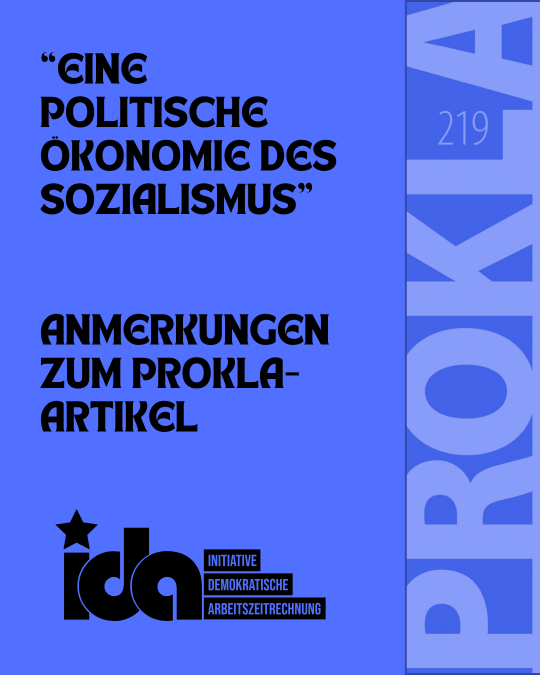Comments on the Prokla Article by IDA: Democratic Planned Economy in Light of Labor Time Calculation
This is a guest contribution by Hermann Lueer. The article refers to our Prokla article from June 2, 2025. Guest articles do not necessarily reflect the position of IDA. We always welcome the submission of guest contributions on the topic of labor time calculation for publication. The text was translated into English with the help of AI.
1. The Role of Socially Average Labor Time
On page 396, you begin discussing self-managed enterprises and their labor time calculations:
“The self-managed enterprises also possess the initiative and far-reaching autonomy in drafting their plans… The total number of hours captured in the plan (referring here to individual enterprise plans) can then be divided by the number of units planned for production, resulting in a labor expenditure per product in hours. This forms the product’s value for contribution.” (p. 396)
This is incorrect, as you yourselves write on page 397:
“It is not the individual labor time that determines the product’s contribution value, but rather the cooperatively determined socially average labor time.” (p. 397)
Anyone reading your first page on basic principles will come to believe that the labor expenditure per product in hours determines its value. This would lead to everyone wanting to purchase from the enterprise with the lowest “price”, thus rendering the entire cooperation absurd.
The correcting sentence on page 397, which is vital for understanding the basic principles, is further weakened by being phrased in the subjunctive:
“Furthermore, enterprises can, in this way, calculate average labor expenditures for products in the same category and then also offer these products at averaged ‘cooperative prices.’”
Beyond these ambiguities in your discussion of labor time calculation, I would have appreciated a more detailed explanation of the distinction between mediation through socially average labor time versus the concept of immediately social labor. This also applies to your merely hinted criticism of “petty-bourgeois, Proudhonist concepts of labor time accounting,” which are crucial.
After all, surely around 90% of the Prokla readership supports modern variants of that idea (e.g., the “Fair Trade” notion).
I’m referring to the fact that in a market economy, the social interconnection of labor is only established behind people’s backs through competition, where productive labor devalues unproductive labor. In contrast, under a labor time calculation system, individual labor time is immediately socially recognized—each member contributing one hour of work receives a product representing one hour of socially average labor, regardless of their efficiency being higher or lower than average. Variations in individual productivity are balanced within the cooperation through public accounting.
The difference from petty-bourgeois, Proudhonist labor time concepts—or the idealism of Fair Trade—lies in the fact that advocates of “just exchange” want to abolish the only regulator—competition—by calling for the elimination of “false” value and “unfair” prices. But in a society of exchanging commodity producers, it is precisely this mechanism that makes members aware—through appreciation or devaluation—of what the society needs or doesn’t need.
These concepts demonstrate a lack of understanding of the laws of capitalist production. Just as Catholicism cannot be abolished by naming the “true” pope, the consequences of capitalist commodity production cannot be eliminated by establishing the “true” value.
(See in detail: MEW 20, p. 278ff; MEW 4, pp. 98ff and 563ff; L.L. Men, What Is Socialism?, pp. 21ff)
2. The Role of Public Accounting
The key task of public accounting—determining the socially average labor time and, based on it, providing the standard valuation for each product group or product—is missing from your account.
You state its main role as:
“… it receives, reviews, and approves the production plans of individual enterprises.”
When you mention socially average labor time, it’s only to say that enterprises, grouped into industry associations, could calculate it.
The way you describe public accounting—“reviewing and approving submitted production plans”—makes me imagine a huge bureaucratic agency. Is it really the idea that every enterprise plan, including every mid-year adjustment, must be reviewed and approved by a higher authority? What happens to the principle of enterprise self-management then?
I believe you’re conflating the enterprise level and the social level of accounting. This is also evident in the following sentence, where you attribute assets to enterprises:
“If the plans are finally approved, enterprises receive the corresponding hour credits from public accounting to obtain production materials, raw materials, and pay their workers.”
How is this supposed to work? What does the supplier do with the hour credit they receive in exchange for their service? Do they use it to pay their employees and suppliers? That would be like circulating digital money. Or does the credit expire at the supplier? Then what’s the point?
With socialized means of production, there can be no enterprise-owned assets. You likely had to book assets in your app because it refers to private-sector labor time accounting. But the “basic principles” assume socialized means of production.
Below I’ll try to outline how I see the tasks of public accounting and the relationship between public accounting and self-managed enterprises, to clarify my objections:
It all starts with enterprise registration in public accounting. When a new production or service enterprise emerges, it must first apply for entry into the public accounting system. This resembles how, under capitalism, enterprises present business plans to banks to obtain credit.
If the enterprise’s societal usefulness is acknowledged, public accounting opens a new accounting circle in its ledger. All operational activities are then recorded there decentrally by the enterprise itself.
Based on this, enterprises operate completely autonomously—similar to capitalism. They draft their annual plans, recruit staff, and establish necessary relationships with their suppliers. They produce their goods and deliver them either to distribution centers or directly to end consumers.
Transactions between enterprises and suppliers are accounted for within the public accounting ledger. Socially average labor times per product are determined annually through public accounting and industry committees, based on enterprise plans or prior experience. Depending on how each enterprise’s productivity deviates from the average, surpluses and deficits emerge in their respective accounting circles, which are balanced in the main ledger of public accounting.
This is merely a social-level clearing. Assets are not transferred to or between enterprises through public accounting.
Thus, enterprises operate independently of societal-level clearing. However, they monitor themselves autonomously based on public accounting. They are supported by public accounting committees that offer advice or criticism when questionable discrepancies or deficits arise, in the interest of the community.
In extreme cases, when the social benefit of an enterprise is seriously in doubt, public accounting can deny further societal clearing by closing the enterprise’s accounting circle.
3. Private vs. Social Labor
You casually write:
“There is, for example, nothing against including household work in labor time accounting.”
I would disagree.
If, for example, I stay at home looking after children, cook, shop, vacuum, and receive labor certificates for this, can I then withdraw products from “social” production? No, because this would disrupt the balance between the necessary contribution of labor and consumer entitlements.
In terms of labor time accounting, I would first have to register as an enterprise. Then I could receive labor certificates for vacuuming and simultaneously offer vacuuming as a product. But that would be absurd when the result of the labor is consumed by me. If I offered my partner vacuuming in exchange for labor certificates and he offered me dishwashing in return, it would be equally absurd.
Without a clear line between private and social labor, labor time accounting cannot function. I could imagine the following distinction: labor done for oneself or within one’s personal circle is private; labor done for anonymous society is potentially socially recognized.
In this context, it’s worth remembering that the gender-specific assignment of household work typical in capitalist production relations will largely lose significance through the implementation of the “equal hour principle.”
Socially relevant household tasks such as elder care or childcare could be handled as social transfer payments—similar to care or child benefits—through a reduction of the Individual Consumption Coefficient (FIK). If this were applied to all household work, however, the FIK would become negative, which would essentially mean the failure of labor time accounting.
4. Public Goods
I continue to be amazed that nearly everyone who supports labor time accounting as a production relationship among free and equal people seems eager to abolish it again—by replacing it largely with public goods:
“Products and services without compensation… This refers initially to enterprises that supply the population with basic necessities such as housing, heating, electricity, healthcare, education, and possibly staple foods, etc.”
With this sentence, you are very close to the model of Sutterlütti and Meretz—even though you rightly criticize it.
Instead of a mostly direct relationship between producer and product, production and distribution would be regulated morally (via “solidarity”) or politically (via overarching institutions).
Why don’t you defend labor time accounting more strongly as a useful tool? Only it enables society’s members to self-manage and rationally regulate their production relations in terms of social effort and output.
It’s contradictory to demand freedom while ignoring reality. True freedom is only possible in a society where people consciously manage their production relations.
When a society declares water or electricity a public good, that doesn’t eliminate the necessary labor behind those services—only the transparency is lost. Water and electricity then become like air: free to use, but their scarcity is regulated through moral appeals to conserve. Rational, responsible use is replaced by moralistic appeals.
Favoring the expansion of public goods instead of labor time accounting opens the door to those who would rather promote rationing “for the good of the population” than self-management.

